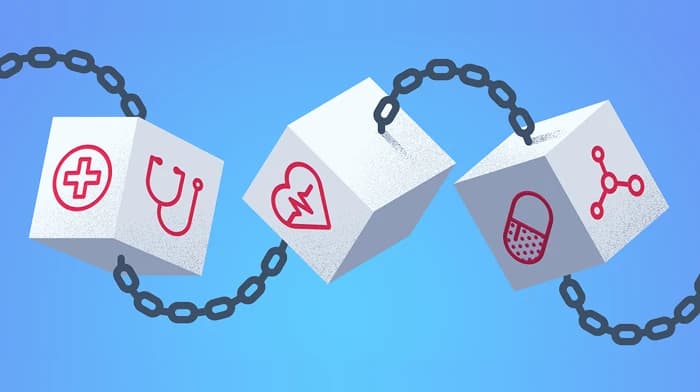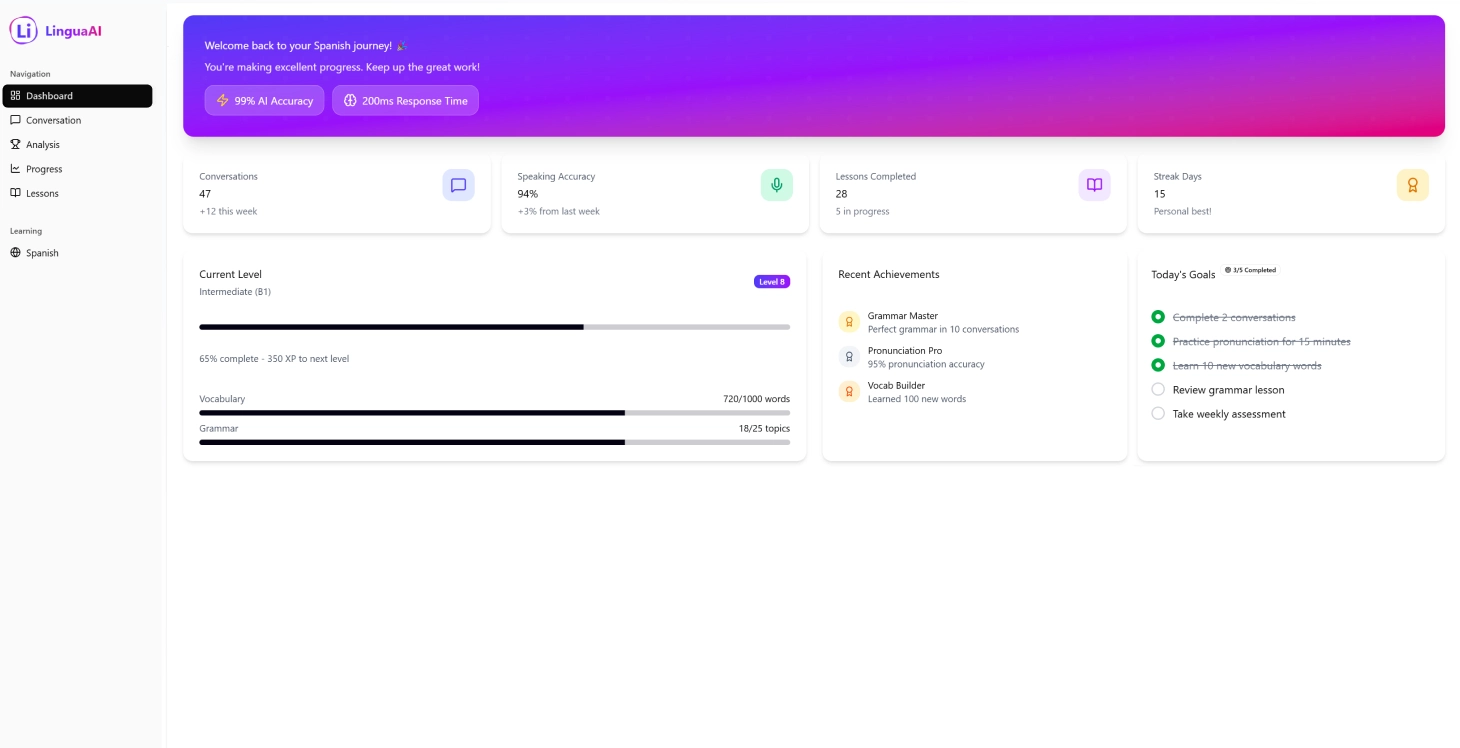
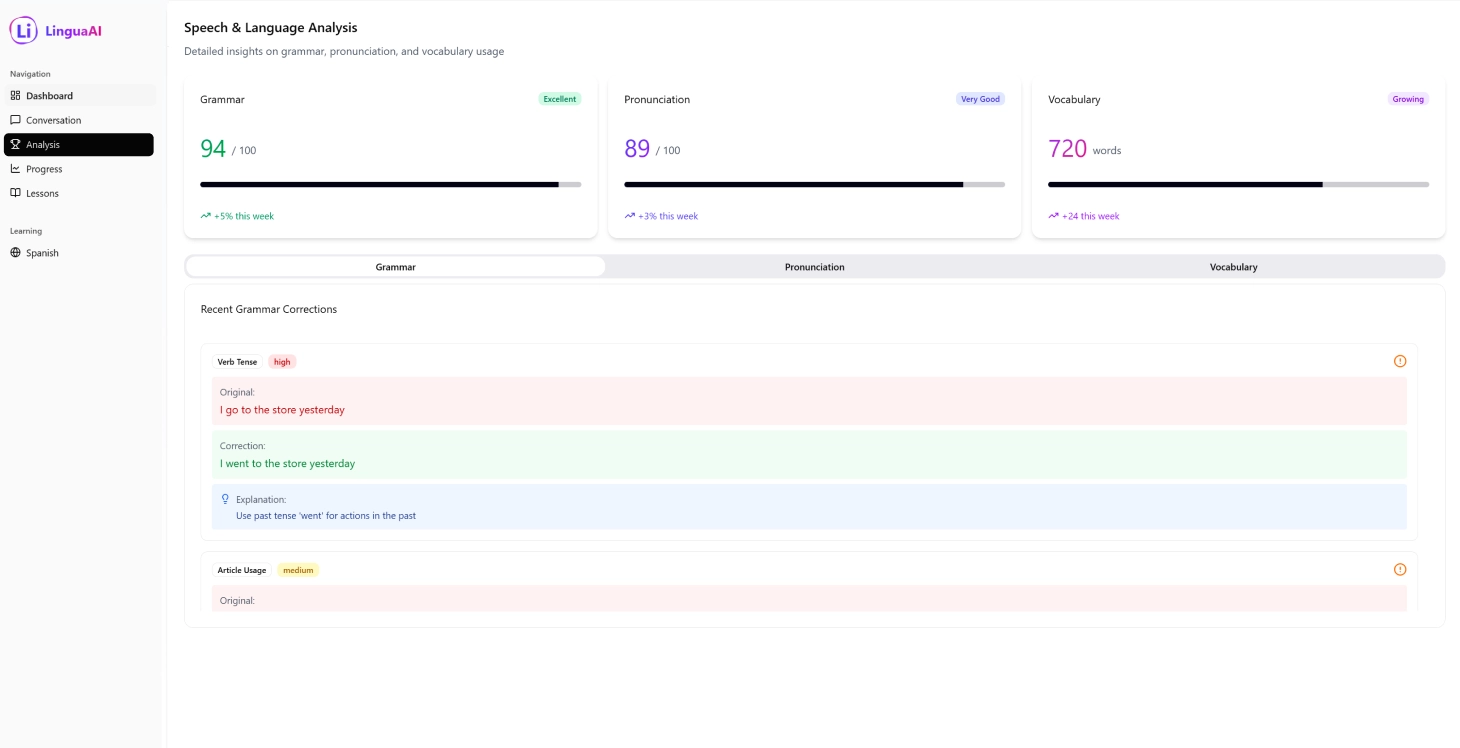
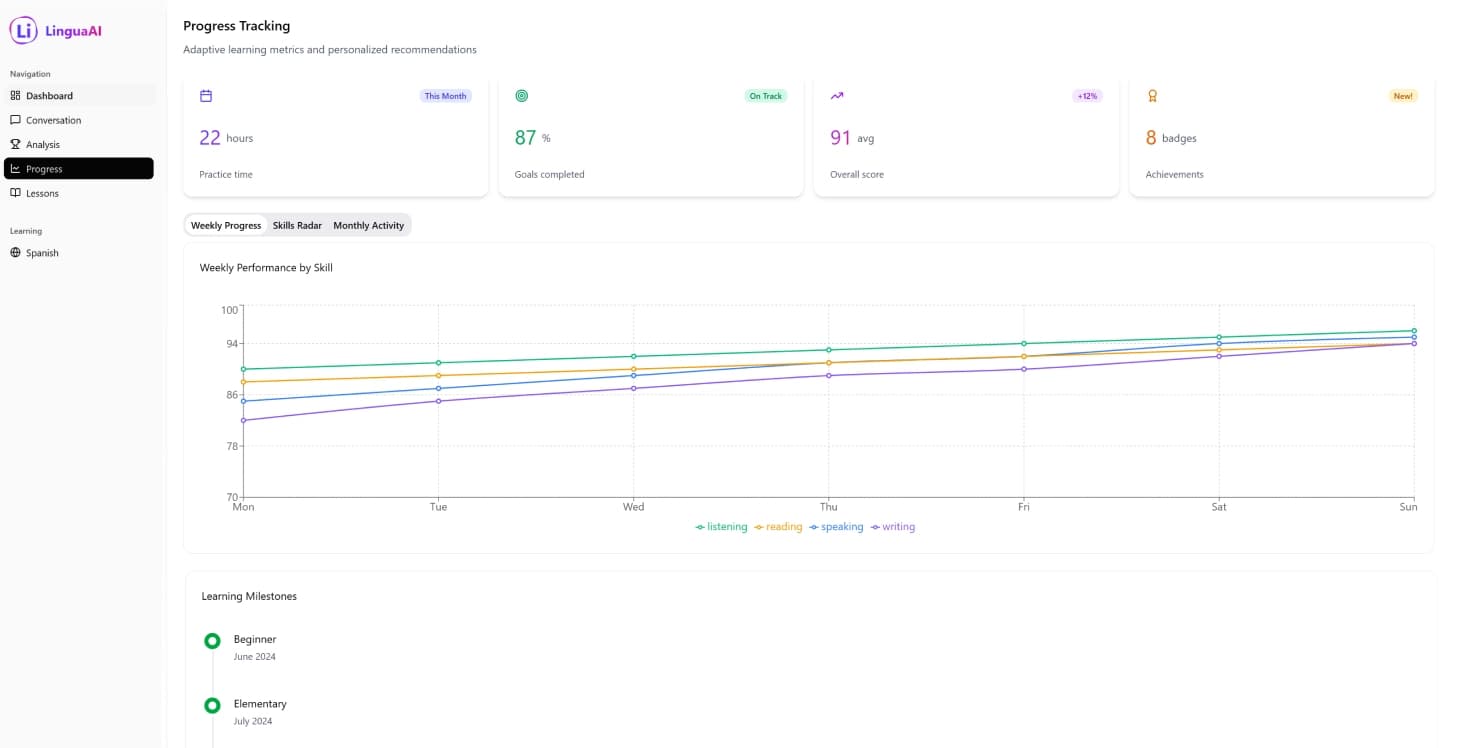
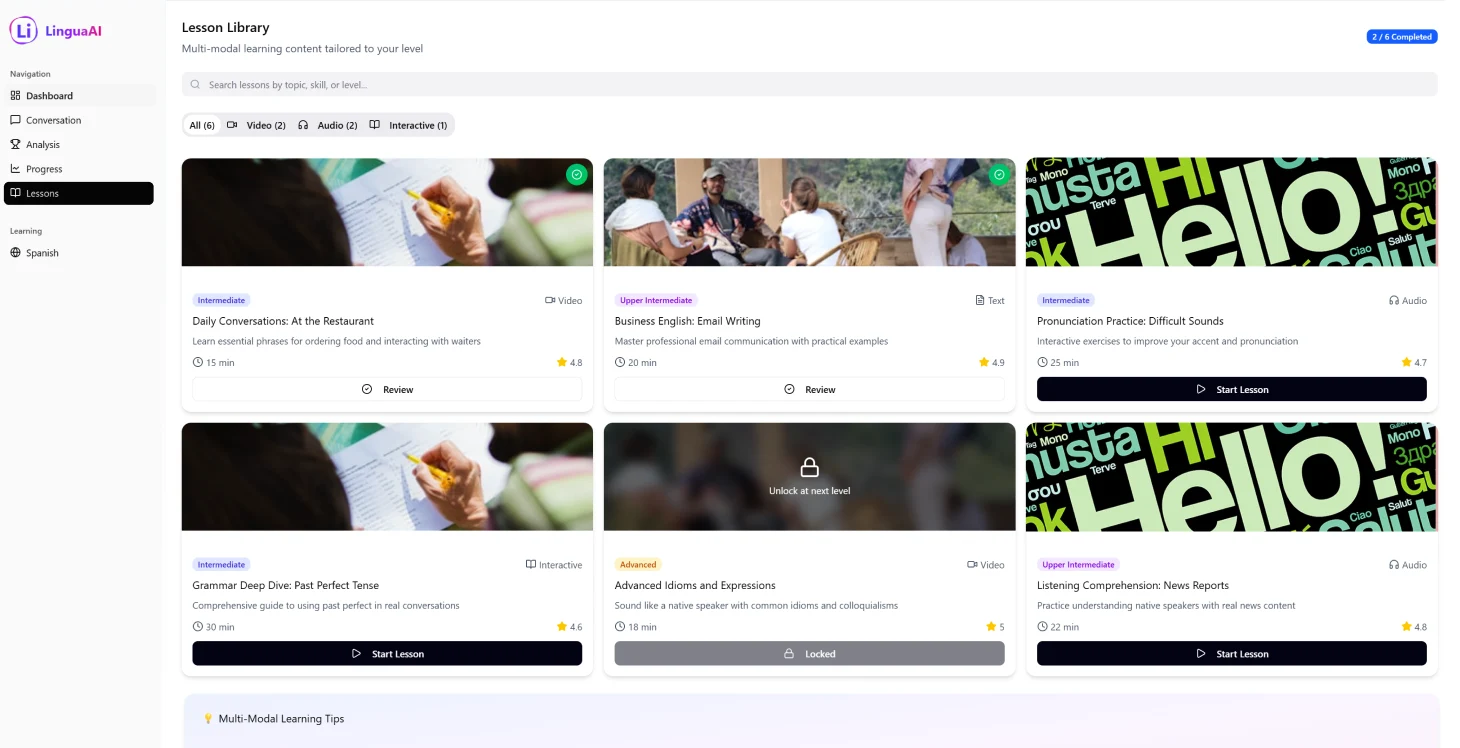
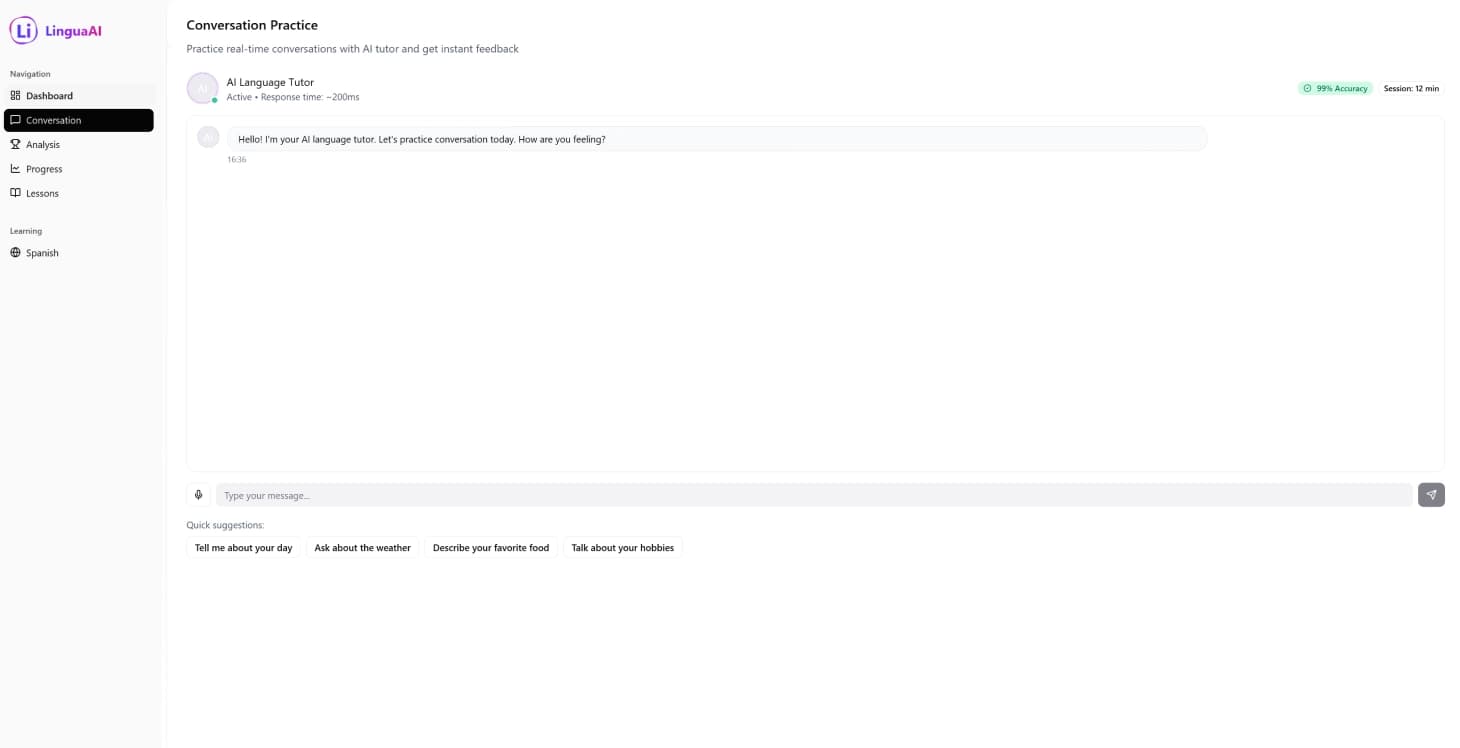
Project Overview
Traditional language learning platforms have not been successful in offering practice and tailored personalization. This has led to restricted development of real world communication skills using AI blockchain integration.
Platform Capabilities
The platform currently accommodates 12 languages, boasting a conversation understanding accuracy of 99% and 200ms response times for sessions.
Traditional Learning Limitations
Traditional language learning typically involves classroom settings and textbooks with limited exposure to native speakers or experienced teachers for practice purposes. To tackle scalability and accessibility issues in education, enterprise blockchain platforms have been developed; however many of these solutions have been stagnant providing prerecorded materials and simple quizzes without feedback or realistic conversations for learners.
Technical Challenges
The intricacies of natural language comprehension and speech understanding have presented challenges for companies in the educational technology sector. Outdated systems have faced difficulties in analyzing conversations in real time and implementing contextual grammar adjustments and adaptive curriculum modifications tailored to individual learning behaviors and skill levels.
Limited Practice Opportunities
The conventional platforms offered limited opportunities for practice by utilizing repetitive drills and prerecorded conversations lacking interactive responses or a natural conversational progression structure.
Standardized Approach Issues
The standardized educational programs did not cater to the individual learning paces of students. They failed to consider their unique preferred methods of learning and cultural backgrounds or address specific skill gaps in listening comprehension and verbal or written expression effectively.
Feedback on grammar and pronunciation typically came from instructors after a delay of hours or days which disrupted the natural learning process and made it harder to remember corrections.
High Dropout Rates
The high rates of people leaving were caused by the exercises being repeated over and over and the lack of personal touch in the programs offered online; this resulted in 75 to 85 percent of users giving up within just one month of starting to use them.
AI-Powered Solutions
Conversational AI Benefits
AI chatbots that engage in conversations offer speaking practice chances which lead to a 67 percent increase in user retention rates and a 45 percent quicker advancement through proficiency levels when contrasted with traditional approaches.
Cost Effectiveness
Automated teaching and evaluation systems have lessened the need for human teachers when it comes to corrections and practice sessions by cutting costs by 40% while maintaining educational quality standards.
Personalized Learning Paths
Machine learning systems examine learning patterns to tailor individual paths and adjust practice intensity and content complexity to cater to numerous learners simultaneously with minimal manual involvement using blockchain consulting approaches.
Experience Personalized Language Learning
Transform your language skills with AI-powered conversations and adaptive learning technology.
Competitive Advantages
Market Impact
In the growing educational technology market, competition is fierce and having natural language processing abilities along with real-time conversation analysis has proven to be a game changer leading to a significant 180 percent uptick in premium subscription sign-ups.
Global Expansion
The quick adoption of languages and incorporation of cultural nuances facilitated swift growth into global markets by introducing personalized AI educators tailored to local language nuances and societal communication norms.
Platform Architecture
Core Technology Stack
The foundation of the platform revolves around chatbots that act as tutors utilizing language models like transformers and real-time speech processing technology alongside adaptive learning algorithms that adapt to each learner's progress and skill levels continuously.
Speech Recognition and Analysis
The tools for speech recognition and text analysis offer insights on:
- Grammar mistakes and pronunciation accuracy
- Vocabulary use analysis
- Real-time error correction during conversational practice sessions
Adaptive Learning Systems
AI text transformation focuses on examining how students engage with content by analyzing their interactions and learning patterns to tailor the curriculum effectively for optimal learning outcomes and engagement levels over time.
Multi-Modal Learning
The blend of text content with visual components alongside interactive features caters to various learning preferences and strengthens language understanding through multiple sensory avenues and real-world contexts.
Implementation Challenges
Infrastructure Costs
Balancing between the expenses for instant AI operations and the need for ongoing model training and updates poses challenges in preserving conversation flow over extended exchanges; yet the advantages of tailored experiences and enhanced engagement validate the added investment in infrastructure.
Speech Processing Pipeline
The speech processing pipeline represents a critical component in language analysis and requires ongoing optimization of curricula by adjusting the sequence and difficulty of content.
Development Phases
Phase 1: Foundation Building
The first phase of the project concentrated on teaching dialogue models for languages of interest and integrating speech recognition features along with setting up adaptive learning processes. Teams working on the project applied transfer learning techniques from existing language models that were already trained in advance to cut down the training period significantly from months to weeks without compromising conversation quality.
Phase 2: Performance Optimization
Performance enhancements targeted reducing delays in chats by using edge computing methods and model compression techniques to ensure responses under 200 milliseconds across worldwide regions. Caching and anticipatory data loading enhanced user satisfaction during peak activity periods.
Advanced Machine Learning Applications
Sophisticated applications of machine learning have allowed for the development of learner profiles and dynamic content creation along with analytics to optimize learning paths effectively. The validation of personalization effectiveness through A/B testing frameworks has also been instrumental in guiding algorithm improvements.
Language Expansion
Expanding language support involves training for cultural context understanding and developing speech models as well as region-specific content creation in collaboration with linguistic experts to ensure accuracy and cultural sensitivity across various languages and regional differences.
User Migration and Continuity
Platform Transition
Progressive methods of moving users to new platforms involve AI tutors offering orientation and guided tours to help them transition from conventional systems smoothly and efficiently while using data import tools that maintain their learning history and progress statistics from compatible systems.
Conversation Continuity
Ensuring conversation continuity was essential for effective tutoring over extended periods of time by keeping track of past discussions and learning goals for smoother AI tutor interactions.
Performance Results
User Engagement Improvements
The AI-driven language learning platform showed significant enhancements in user interaction and educational performance metrics while confirming the effectiveness of AI in educational tech applications.
The platform's user engagement metrics displayed substantial improvements compared to traditional learning techniques; users devoted more time to interactive learning sessions and prolonged their educational endeavors extensively.
Technical Performance
Real-time artificial intelligence processing successfully met the desired levels of speed and precision while also expanding effectively to cater to increasing user populations across geographical areas.
Growth Metrics
| Metric | Previous | Current | Growth |
|---|---|---|---|
| Monthly Active Users | 45,000 | 180,000 | 300% |
| Response Latency | 500ms | 340ms | 32% improvement |
| User Retention | 25% | 67% | 168% improvement |
Conversation Quality
During tutoring sessions where conversations continue over time without interruption, advanced techniques are needed to keep track of the discussion and remember key points effectively to ensure high-quality exchanges even after multiple interactions.
Development Challenges and Solutions
Cultural Sensitivity Issues
In the beginning stages of development, the main priority was ensuring grammatical accuracy without considering the importance of cultural context in interactions. Feedback from users highlighted that culturally insensitive responses had a negative impact on how well users learned and trusted the system. This realization prompted the integration of cultural training data to address these issues.
Personalization Balance Challenges
Aggressive personalization algorithms sometimes led to filter bubbles that restricted learners from encountering diverse content, prompting the need for ongoing algorithm adjustments and consultations with educational experts to maintain a balance between personalized learning and increasing difficulty levels over time.
Performance vs Quality Trade-offs
To achieve response times under 200 milliseconds involved using methods to make the model smaller which initially impacted conversation quality negatively. Through a series of improvements and adjustments over time, we were able to find a balance between speed and educational success by combining various processing methods.
Scalability Challenges
In the early stages of architecture development, focus was more on features rather than scalability which led to performance slowdowns as the user base expanded. Moving towards microservices and distributed processing helped overcome scalability issues but demanded significant reworking efforts.
Metrics vs Learning Outcomes
Focusing too much on engagement metrics without looking at the bigger picture of overall learning outcomes can be counterproductive in the long run. Initially prioritizing conversation volume resulted in less meaningful interactions that ultimately hindered learning effectiveness despite seeing an increase in engagement statistics.
Technical Infrastructure
Real-Time Communication
Real-time communication is facilitated through WebRTC, which enables optimized voice interactions with minimal latency.
Monitoring and Analytics
Logging and performance tracking systems are essential for comprehensive monitoring and observability of the platform's performance and user interactions.
The combination of advanced AI technology, personalized learning approaches, and real-time feedback creates an optimal environment for language acquisition and skill development.
Project Results
- 99% conversation understanding accuracy achieved
- 200ms response times maintained globally
- 300% growth in monthly active users
- 67% improvement in user retention rates
- 45% faster progression through proficiency levels
Key Performance Metrics
User Growth
Monthly active users increase
Response Time
Global response latency
Retention Rate
User retention improvement
Learning Speed
Faster proficiency progression
